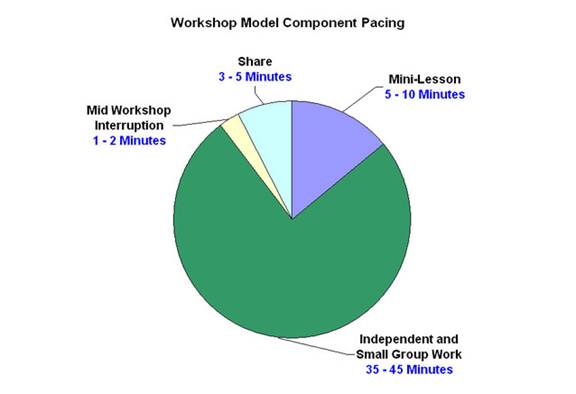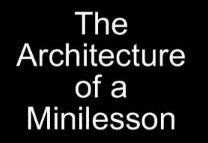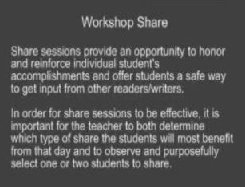I have finally realized that the most creative environments in our society are not the kaleidoscopic environments, in which everything is always changing and complex. They are instead, the predictable and consistent ones - the scholar's library, the researcher's laboratory, the artist's studio. Each of these environments is deliberately kept predictable and simple because the work at hand and the changing interactions around that work are so unpredicable and complex (Calkins, 1986).
Setting aside predictable time for writing and reading every day is important and essential in a balanced literacy curriculum. Perhaps most importantly, workshop teaching - whether reading workshops, writing workshops, or math workshops are designed to provide learners with long stretches of time to carry on with some independence. In daily reading and writing workshops, students are explicitly taught how to become proficient readers and writers. The reading and writing workshop approach helps build a community of readers and writers through teacher support, collaboration with peers and opportunities for independent reading and writing. In addition, the workshop approach helps teachers address the needs of students by organizing them into flexible groups as well as working with them individually. Finally, reading and writing workshops provide students with good literacy habits by engaging them in meaningful literacy activities that help to develop their literacy skills.
Not only is it important that reading and writing have a predictable place in the schedule so that students anticipate and plan for it, it is also important that the workshop itself have a simple structure. Although there are variations to the workshop structure, the basic components include the following: the minilesson, independent and small group practice, conferring, mid-workshop interruption and share session.
Calkins, L., (1986). The Art of Teaching Writing. Portsmouth, NH: Heinemann.
Here is an example of how a workshop might be structured:
The first part of the workshop, is the minilesson, which is usually between five and ten minutes long. The minilesson is a time to gather the whole class together to teach the students a new strategy about reading or writing. The most effective minilessons tend to follow a simple structure. While the content of the minilesson changes from day to day, the architecture of the minilesson remains the same.
- Connection: Minilessons begin with the connection. Teachers tell students what they will be teaching them (i.e., the teaching point), talk about how the lesson fits into the work they have been doing and help students access prior knowledge.
- Teaching: The teaching component of the lesson includes the teacher naming the strategy that students will learn and explaining why readers and/or writers use this strategy (i.e., teaching point and its purpose). The teacher then demonstrates the strategy, drawing students attention to the strategy being modeled by repeatedly using the phrases "watch me as I ..." and "did you notice...".
- Active Engagement: The active engagement is a critical component of the minilesson, because it gives students the opportunity to try out what they have just seen demonstrated by the teacher.
- Link: Teachers link the minilesson to the ongoing work of the day's workshop. The goal is that students will transfer the work of the minilesson to their independent work, thereby making it part of their ongoing repertoire of skills and strategies.
Attachments:
Minilesson Planning Sheet
Minilesson Template
The Architecture of Effective Minilessons
Videotape Introduction
Independent and Small Group Work
As students work independently during the workshop, the teacher confers with individuals and leads small groups to provide responsive, differentiated instruction. In the reading workshop, guided reading groups and reading strategy groups are used to provide small group support while in writing workshop guided writing groups and writing strategy groups are used. Using ongoing assessment data, teachers form these flexible groups and gather students together who share a similar writing/reading need. Similar to a conference, the purpose of small group work is to provide instruction on one targeted reading/writing strategy. (For more information on the different types of small group work, view the "Components of Balanced Literacy" web pages.)
While students are working independently, the teacher spends time conferring with individual students. A conference should feel like a conversation between teacher and student. Although conferences are brief, ranging from two to five minutes in length, they are incredibly productive since they focus on the specific needs of one student. Conferences are a critical component of the workshop because they can be aimed at providing a student with support and extra practice on a previously taught strategy but can also be used to provide enrichment for students who have already mastered a certain strategy. Although conferences are responsive and each conference is unique, they nevertheless do have a predictable structure. The architecture of the conference is outlined below.
- Research: Teachers begin a conference by researching what students know. Teachers observe, interview and review artifacts of student work as ways to understand what the student is trying to do as a writer/reader. By interviewing or asking the student questions, the teacher is able to glean more about the student's intentions. A teacher may begin a conference, for example, by asking, "How is it going?", or "Can you tell me what you're working on as a reader/writer today?"
- Compliment: The teacher will name out a specific strategy that the student has been able to do as reader/writer to show that the teacher values and hopes the student will continue to use that strategy. Compliments are most effective when they are used as a teachable moment, in other words, when teachers give specific compliments that explicitly name a strategy, such as, "I love the way you have your characters talking and you include their exact words. That's just what writers do," rather than giving a generic compliment like "Good job."
- Decide: Based on the research the teacher decides one strategy to teach the reader/writer and how she/he will teach it. Often there will be many possible teaching points, the teacher will weigh the possibilities and select the one which will advance the work of the reader or writer the greatest at that moment.
- Teach: The teacher explicitly names the strategy that the student will learn as well as its purpose (i.e., why writers/readers use this strategy). The teacher demonstrates the strategy, narrating each step and drawing attention to each step by using language such as "Watch me as I show you...," and "Did you notice how I..." The teacher then offers the student guided practice, or coaching, while the student practices the strategy in his/her book or piece of writing. (This is similar to the teaching and active engagement components of the minilesson.)
- Link: The teacher ends the conference by renaming for the student the strategy learned and reminding the student to use it often in his/her reading/writing. The goal of any conference is to teach the reader/writer a strategy that he/she can transfer to other texts he/she reads/writes.
The mid-workshop interruption is a brief opportunity for the teacher to ask students to pause in their independent work and listen for a verbal reminder about a strategy to use. A teacher may for example, highlight a strategy she/he just observed one student using, remind students of the strategy learned in that day's or a previous day's minilesson while at other times use this opportunity as a way to reengage students with their work. Since this is a quick reminder, students remain where they are working rather than come together in the meeting area as they do for a minilesson.
The share session, which is typically three to five minutes long, is the final component of the reading/writing workshop and a time for the class to gather back together and discuss their work. Leading literacy expert Katie Wood Ray (1999) emphasizes the importance of the writing workshop share. She writes, Writers need to talk about their writing, and the thing that seems to make or break many writing workshops is the presence (or absence) of productive talk.
In her book, Don't Forget to Share, Leah Mermelstein describes in detail the importance of this aspect of the workshop and how this time can be used for maximum instructional impact. Share sessions are critical to the success of a reading/writing workshop according to Mermelstein because they provide an opportunity to honor and reinforce individual student's accomplishments, while at the same time offer students a safe way to get input from other readers/writers. In order for share sessions to be effective, it is important for the teacher to both determine which type of share the students will most benefit from that day and to observe and purposefully select one or two students to share. A teacher makes this decision by paying attention to what occurs in the minilesson, conferences, as well as observing students while they are reading/writing.
Mermelstein describes four types of share sessions a teacher may alternate using in his/her writing workshop. Although Mermelstein focuses these shares around the writing workshop, it is easy to reimagine each one as an effective closing to the reading workshop. Mermelstein details in depth four types of share sessions which are the content share, craft share, process share and progress share.
- Content Share: During a writing workshop content share, one or two students read their writing aloud. After each student reads, the teacher asks the rest of the students to retell what they heard to make sure everyone understands it. Then the students ask for more information. Finally, the writer decides which parts of the discussion (if any) will help him/her revise the writing.
- Craft Share: In a craft share, one or two students share a technique they have tried in their writing. Then the rest of the students either reread their piece of writing, imagining what it would sound like if they revised it using this technique, or rehearse how they might use the technique in a future piece. Either way, students document their new craft ideas so they can refer to them during future writing workshops. Finally, students share their ideas in pairs.
- Process Share: In a process share, the teacher poses a question that pertains to the writing process: What do you do when you don't know how to spell a word? What do you do when you don't know what to write about? The students may or may not bring their writing with them, depending on what they will talk about. Then the students explore the question, using all of their prior writing experiences to help them.
- Progress Share: A progress share unfolds in one of two ways. Sometimes the conversation is focused around everybody's progress; sometimes it's focused on just one person's progress. In a progress share centered on everybody's progress, the teacher poses a question such as, How has your writing improved in this unit of study? The students may or may not bring their writing with them, depending of what they will be talking about. The students then discuss the question and set goals for their future writing. In a progress share focused on one person's progress, that student shares his/her progress (and perhaps writing) with the class. Afterward, the classmates, use that student's breakthrough as a springboard for discussing their own writing goals.
Mermelstein, L., (2007). Don't Forget to Share. Portsmouth, NH: Heinemann.
Ray, K. W. (1999). Wondrous Words:Writers and Writing in the Elementary Classroom. Urbana, IL: National Council of Teachers of English.




